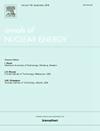Wide wall liquid film thickness distribution in narrow rectangular geometry for annular flow
IF 1.9
3区 工程技术
Q1 NUCLEAR SCIENCE & TECHNOLOGY
引用次数: 0
Abstract
Annular flow in narrow rectangular geometries is critical for high-efficiency heat transfer systems, yet existing models—primarily developed for circular pipes—fail to capture the two-dimensional film thickness distribution inherent to asymmetric channels. This study addresses this gap by proposing a novel methodology that adapts conventional one-dimensional film thickness models to rectangular geometries through geometric and hydrodynamic considerations. Three characteristic lengths (hydraulic diameter, center-to-wall distance, and narrow gap) and two velocity profiles (1/7th power law turbulence and pressure-drop-derived phase separation) are systematically integrated into six methodologies to predict wide-wall film thickness. Validated against experimental data from a 200 mm × 10 mm rectangular channel, the results demonstrate that Method 6—combining hydraulic diameter and pressure-drop-derived superficial liquid velocity—achieves better accuracy by accounting for gas-core dominance at the channel center and confinement effects. While the framework reliably predicts wide-wall film thinning, challenges persist near the narrow wall due to flow regime transitions. This work advances the theoretical foundation for annular flow modeling in non-circular geometries, offering critical insights for enhancing thermal–hydraulic safety in nuclear reactors, compact heat exchangers, and high-power electronics cooling systems.
环空流动宽壁液膜厚度窄矩形几何分布
窄矩形几何形状的环空流动对于高效传热系统至关重要,然而现有的模型(主要是为圆形管道开发的)无法捕捉非对称通道固有的二维膜厚分布。本研究通过提出一种新颖的方法来解决这一差距,该方法通过几何和流体力学的考虑,将传统的一维薄膜厚度模型适应于矩形几何。三种特征长度(液压直径、中心到壁距离和窄间隙)和两种速度分布(1/7次幂律湍流和压力降衍生相分离)被系统地集成到六种方法中,以预测宽壁膜厚度。通过对200 mm × 10 mm矩形通道的实验数据进行验证,结果表明,考虑到气芯在通道中心的优势和约束效应,结合水力直径和压力降推导的表面液体速度的方法6获得了更好的精度。虽然该框架可靠地预测了宽壁膜变薄,但由于流动模式的转变,在窄壁附近仍然存在挑战。这项工作推进了非圆形几何环流建模的理论基础,为提高核反应堆、紧凑型热交换器和大功率电子冷却系统的热水力安全性提供了重要见解。
本文章由计算机程序翻译,如有差异,请以英文原文为准。
求助全文
约1分钟内获得全文
求助全文
来源期刊

Annals of Nuclear Energy
工程技术-核科学技术
CiteScore
4.30
自引率
21.10%
发文量
632
审稿时长
7.3 months
期刊介绍:
Annals of Nuclear Energy provides an international medium for the communication of original research, ideas and developments in all areas of the field of nuclear energy science and technology. Its scope embraces nuclear fuel reserves, fuel cycles and cost, materials, processing, system and component technology (fission only), design and optimization, direct conversion of nuclear energy sources, environmental control, reactor physics, heat transfer and fluid dynamics, structural analysis, fuel management, future developments, nuclear fuel and safety, nuclear aerosol, neutron physics, computer technology (both software and hardware), risk assessment, radioactive waste disposal and reactor thermal hydraulics. Papers submitted to Annals need to demonstrate a clear link to nuclear power generation/nuclear engineering. Papers which deal with pure nuclear physics, pure health physics, imaging, or attenuation and shielding properties of concretes and various geological materials are not within the scope of the journal. Also, papers that deal with policy or economics are not within the scope of the journal.
 求助内容:
求助内容: 应助结果提醒方式:
应助结果提醒方式:


